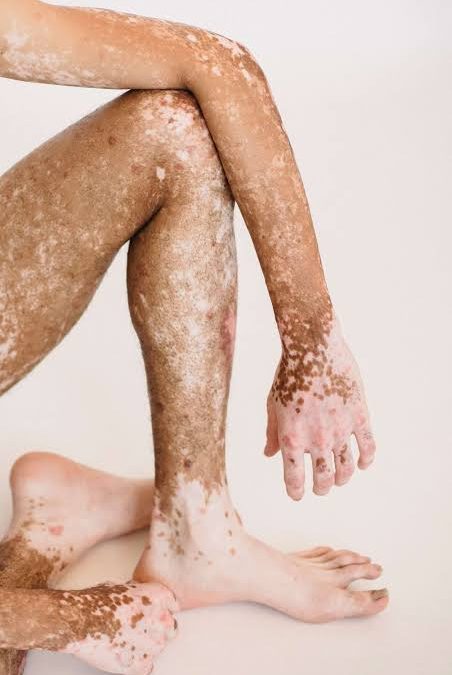In the mirror, a puzzle stared back at me – a patchwork of pale skin, like pieces of a canvas torn apart. Vitiligo, the thief of pigment, had struck again, leaving its mark on my body like a whispered secret. I felt like a masterpiece, once whole and vibrant, now fragmented and faded. But as I gazed deeper, I saw something else – a glimmer of resilience, a spark of determination. I vowed to reassemble the pieces, to find the missing colors and reclaim my skin.
The journey was not easy, like navigating a maze with no clear exit. There were twists and turns, dead ends and false starts. But with each step, I found my footing, my voice, my strength. I discovered the beauty of imperfection, the power of embracing the unknown. And slowly, incrementally, the patches began to fade, like whispers in the wind. The colors returned, like sunrise over a darkened landscape – soft pinks, warm browns, radiant whites. I was reassembling, rediscovering, reborn.
Today, I stand before the mirror, a tapestry of triumph. The patchwork puzzle, once a symbol of shame, now shines like a badge of honor. I am a masterpiece, reimagined, renewed. Vitiligo may have taken my pigment, but it couldn’t steal my spirit. I am a canvas of hope, a testament to the human heart’s capacity to heal, to adapt, to overcome. And as I gaze into the mirror, I whisper a promise – to myself, to others – that no matter the puzzle, no matter the pieces, we can always find a way to make it whole again.
What is Vitiligo?

Vitiligo is a chronic autoimmune skin condition characterized by the loss of pigment-producing cells (melanocytes), leading to white patches or spots on the skin. It can affect any area of the body, but most commonly appears on the face, hands, feet, and genital areas.
There are several types of vitiligo, including:
1. Non-segmental vitiligo: Most common form, characterized by symmetrical patches on both sides of the body.
2. Segmental vitiligo: Patches appear on one side of the body, often in a specific area.
3. Mixed vitiligo: Combination of non-segmental and segmental vitiligo.
4. Acrofacial vitiligo: Affects the face, hands, and feet.
5. Vulgaris vitiligo: Most common form, characterized by scattered patches.
6. Focal vitiligo: Small, localized patches.
7. Mucosal vitiligo: Affects the mucous membranes (inside the mouth, nose, etc.).
8. Universal vitiligo: Rare form, where most of the body’s skin is affected.
9. Hypopigmented vitiligo: Skin lightens but doesn’t completely lose pigment.
10. Trichrome vitiligo: Characterized by three shades of skin color: normal, hypopigmented, and depigmented.
Additionally, vitiligo can be classified into:
– Active vitiligo: Patches are expanding or new patches are appearing.
– Stable vitiligo: Patches are not changing or expanding.
– Progressive vitiligo: Patches are gradually expanding over time.
Understanding the type and severity of vitiligo helps determine the best course of treatment.
Causes
1. Genetic predisposition: Family history increases the risk of developing vitiligo.
2. Autoimmune response: The immune system mistakenly attacks and destroys melanocytes (pigment-producing cells).
3. Hormonal changes: Stress, thyroid disorders, or other hormonal imbalances may trigger vitiligo.
4. Skin trauma: Injuries, burns, or surgical scars may lead to vitiligo.
5. Vitamin deficiencies: Lack of vitamins like B12 or D may contribute to vitiligo.
6. Oxidative stress: Imbalance between free radicals and antioxidants may damage melanocytes.
7. Neurogenic factors: Nerve damage or dysfunction may contribute to vitiligo.
8. Environmental factors: Exposure to chemicals, toxins, or UV radiation may trigger vitiligo.
9. Stress: Physical or emotional stress may trigger or exacerbate vitiligo.
10. Other medical conditions: Certain conditions like diabetes, thyroid disease, or alopecia areata may increase the risk of developing vitiligo.
Triggers:
1. Sunburn or skin trauma
2. Stressful events
3. Hormonal changes
4. Exposure to chemicals or toxins
5. Viral infections
Risk factors for vitiligo include:
1. Family history: Having a family member with vitiligo increases the risk.
2. Genetic predisposition: Certain genetic markers may increase the risk.
3. Autoimmune disorders: Having a history of autoimmune diseases like thyroid disease, diabetes, or rheumatoid arthritis.
4. Skin trauma: Injuries, burns, or surgical scars may trigger vitiligo.
5. Hormonal changes: Stress, thyroid disorders, or other hormonal imbalances.
6. Vitamin deficiencies: Lack of vitamins like B12 or D.
7. Oxidative stress: Imbalance between free radicals and antioxidants.
8. Neurogenic factors: Nerve damage or dysfunction.
9. Environmental factors: Exposure to chemicals, toxins, or UV radiation.
10. Age: Vitiligo can occur at any age, but most cases appear between 20 and 40.
11. Sex: Both males and females are equally affected, but females are more likely to develop vitiligo.
12. Ethnicity: Vitiligo affects all ethnicities, but is more common in certain populations (e.g., Indians, Africans).
13. Other medical conditions: Certain conditions like alopecia areata, psoriasis, or eczema may increase the risk.
14. Stress: Physical or emotional stress may trigger or exacerbate vitiligo.
15. Exposure to chemicals: Certain chemicals like phenol, catechol, or monobenzyl ether of hydroquinone may trigger vitiligo.
Prevention
1. Protect your skin from the sun: UV radiation can trigger vitiligo.
2. Manage stress: High stress levels may trigger or exacerbate vitiligo.
3. Maintain a healthy diet: Ensure adequate vitamin B12, vitamin D, and antioxidant intake.
4. Avoid skin trauma: Prevent injuries, cuts, and burns.
5. Don’t smoke: Smoking may increase the risk of vitiligo.
6. Limit chemical exposure: Avoid harsh chemicals, toxins, and dyes.
7. Get enough sleep: Aim for 7-8 hours of sleep per night.
8. Exercise regularly: Maintain a healthy lifestyle.
9. Monitor for autoimmune diseases: If you have a family history, be aware of signs and symptoms.
10. Consult a doctor: If you notice any unusual skin changes or patches.
Additionally, some natural remedies and supplements may help:
1. Turmeric: Anti-inflammatory properties
2. Ginkgo biloba: Antioxidant properties
3. Vitamin B12 supplements: Ensure adequate levels
4. Omega-3 fatty acids: Anti-inflammatory properties
5. Aloe vera: Soothing and anti-inflammatory properties
Remember, these measures are not a guarantee against developing vitiligo, but they may help reduce the risk or slow its progression. If you have concerns, consult a doctor or dermatologist.
Treatment and management of vitiligo aim to:
1. Stop the progression of the disease
2. Promote repigmentation
3. Improve skin appearance
4. Manage symptoms and side effects
Medical Treatments:
1. Topical corticosteroids
2. Topical immunomodulators
3. Light therapy (UVB, narrowband UVB, or excimer laser)
4. Systemic corticosteroids (short-term)
5. Immunomodulatory medications
6. JAK inhibitors (for severe cases)
Surgical Options:
1. Skin grafting
2. Melanocyte transfer
3. Tattooing (for small areas)
Alternative Therapies:
1. Herbal remedies (e.g., turmeric, ginkgo biloba)
2. Acupuncture
3. Mind-body therapies (e.g., stress management, meditation)
4. Dietary changes (e.g., increasing vitamin B12, omega-3 fatty acids)
Lifestyle Modifications:
1. Sun protection (sunscreen, clothing)
2. Stress management
3. Healthy diet
4. Regular exercise
5. Avoiding skin trauma
It’s important to note that:
– Each individual’s response to treatment may vary
– Combination therapies may be more effective
– Treatment should be tailored to the individual’s needs and skin type
– Patient education and support are crucial for successful management
Consult a doctor or dermatologist to determine the best course of treatment for your vitiligo.

